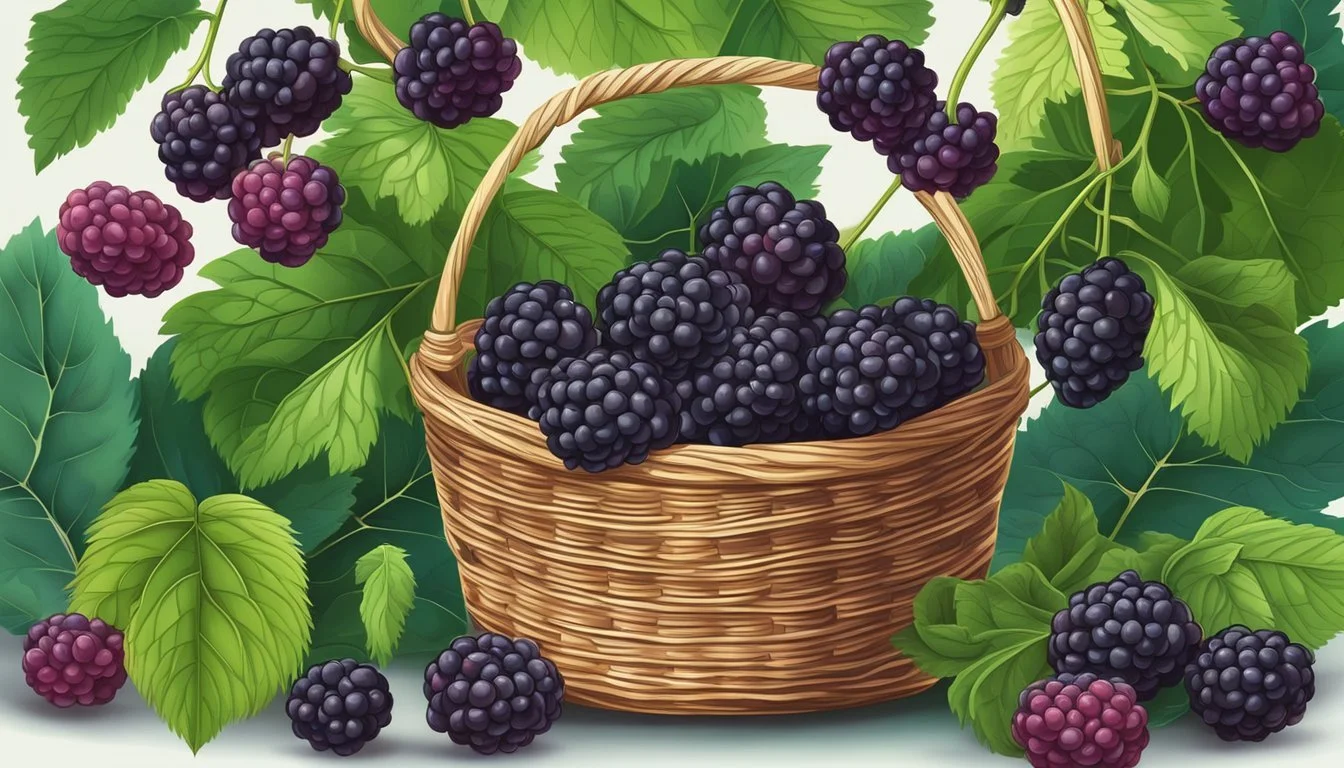How Do You Eat Mulberries?
Unveiling the Simple Ways to Enjoy This Fruit
Mulberries are a versatile and nutritious fruit that can be enjoyed in a variety of ways. With their sweet flavor and rich nutritional profile, they offer a unique addition to any diet. These berries are not only a great source of vitamins and minerals but also contain dietary fiber, which contributes to improved digestion and overall gut health. When eating mulberries, one can appreciate their ability to complement both sweet and savory dishes, making them a suitable ingredient for a wide range of recipes.
The consumption of mulberries can be as simple as eating them fresh, adding a burst of natural sweetness to any day. For those looking to incorporate mulberries into their meals, options abound. They can be simmered into jams, layered into parfaits with yogurt and granola, or used as a topping for oatmeal and pancakes. Their versatility extends to baking, where they can be easily substituted for other berries in muffins, scones, and quick bread recipes. Whether one chooses to enjoy mulberries on their own or as part of a culinary creation, these berries offer both flavor and nutritional benefits.
As an ingredient with historical roots and culinary flexibility, mulberries present an opportunity to elevate ordinary dishes with their distinct taste and health properties. Coupled with their potential to support cardiovascular and immune health, mulberries are increasingly recognized for their contributions to a balanced and health-conscious diet. Whether freshly picked or bought from the market, mulberries can be seamlessly woven into daily eating habits, enriching the palette with minimal effort.
Identifying Mulberries
Before one can enjoy the sweet taste of mulberries, it is essential to correctly identify the fruit and ensure it is ripe. This section covers the key aspects of recognizing different varieties of mulberries and determining their ripeness.
Mulberry Varieties
Mulberries come in mainly three species, which can be distinguished by the color of their fruit:
Morus rubra: This species is commonly known as the red mulberry and is native to eastern North America. The fruit is deep red to purple in color when ripe.
Morus nigra: Known as the black mulberry, this species originated in western Asia and the fruit ripens to a rich black color.
Morus alba: The white mulberry, which originates from Asia, can produce white, pink, or purplish fruits (What wine goes well with fruits?), though white is rarer.
Each species may have different leaf patterns and sizes, but the fruit’s appearance is a more reliable characteristic for identification.
Spotting Ripeness
Determining the ripeness of mulberries is crucial, as they are only edible in their ripe form:
Color: A ripe mulberry will typically have a deep, almost black color for black mulberries, a robust red for red varieties, or a pinkish tint for the rarer white mulberries.
Feel: They should be soft to the touch. If the berry is firm, it may require more time to ripen.
Taste: A ripe mulberry should taste sweet. If there is any hint of sourness or bitterness, the berry may not be ready to eat.
Nutritional Profile of Mulberries
Mulberries are a nutrient-rich fruit, known for their content of essential vitamins, minerals, and beneficial compounds. They have a distinctive nutritional value that supports various aspects of health.
Vitamins and Minerals
Mulberries are an excellent source of Vitamin C, carrying 36.4 mg per 100 grams which serves as 61% of the recommended daily intake (RDI). They are also rich in Vitamin K, vital for bone health, and iron, which is crucial for blood health. Furthermore, mulberries offer good amounts of calcium and potassium, minerals essential for bone strength and heart health, respectively. In terms of vitamins, Vitamin E is also present, contributing to skin health and acting as an antioxidant.
Vitamin C: 36.4 mg (61% RDI)
Vitamin K: Significant contribution
Iron, Calcium, Potassium: Essential minerals present
Vitamin E: Acts as an antioxidant
Antioxidants and Phytonutrients
Mulberries contain various antioxidants, such as resveratrol and anthocyanins, which play a role in reducing oxidative stress and may help in protecting the body against chronic diseases. The antioxidant properties of mulberries contribute to their overall health benefits, such as potentially supporting the immune system and slowing down aging. Anthocyanins, which give the fruit its dark color, are known for their potential to support heart health.
Resveratrol: Known antioxidant with potential health benefits
Anthocyanins: Contributes to the fruit's color and potential heart health benefits
In addition to antioxidants, mulberries provide dietary fiber, which aids in digestion, and they contain a relatively high level of protein compared to other berries. They offer a balance of nutrients with moderate calories and sugar content.
Fiber: 1.7% of fresh weight
Protein: Higher content relative to most berries
Calories: 60 per cup (140 grams)
Sugar: Balanced content within nutritional profile
Health Benefits of Mulberries
Mulberries are not only delicious but also pack a wealth of health benefits. These small fruits are powerhouses of nutrients that can support heart health, enhance immune function, and aid in digestion due to their high content of vitamins, minerals, and antioxidants.
Supporting Heart Health
Mulberries contain compounds that contribute to heart health. Specifically, they are rich in antioxidants that help combat oxidative stress and may reduce the risk of heart disease. These fruits have been found to influence blood sugar control and help in lowering LDL ("bad") cholesterol, which is crucial for maintaining a healthy heart.
Boosting Immune Function
The immune-boosting properties of mulberries are significant. These little fruits are dense with vitamin C and iron, both of which are essential in fortifying the body’s defenses. Eating mulberries can be an effective strategy to supply the body with anti-inflammatory and antioxidant elements, promoting overall immune resilience.
Improving Digestion
High in dietary fiber, mulberries aid in improving digestion by promoting regular bowel movements and preventing constipation. They support the digestive system not only by contributing to the volume of one's stool but also by encouraging the growth of healthy gut bacteria, which is fundamental for proper digestion and absorption of nutrients.
Culinary Uses of Mulberries
Mulberries offer an array of culinary possibilities, from sweets to beverages, their versatility is evident in the wealth of recipes incorporating this delicate fruit.
Creating Sweet Treats
They can be the star in a variety of sweet treats. For instance:
Mulberry Jam: For a classic spread, they are simmered with sugar and a splash of lemon juice to thicken into jam.
Mulberry Sorbet and Ice Cream: These offer a refreshing option for dessert, pairing well with creamy textures.
Fruit Leather: With their natural sweetness, they are ideal for homemade fruit leathers.
Cooking and Baking
In cooking and baking, they are a versatile ingredient:
Muffins and Cakes: Easily substituted for other berries in muffin or cake recipes.
Mulberry Pie: A delightful dessert, mixing the berries with sweeteners and spices to fill a flaky crust.
Oatmeal: Topping oatmeal with fresh mulberries adds a burst of flavor.
Beverages and Infusions
As for beverages:
Mulberry Tea: Steeping the leaves or berries to create a soothing tea.
Mulberry Wine: Their juice ferments into a unique and delightful wine.
Smoothies: A handful can enrich any smoothie recipe, adding both flavor and nutrients.
Whether using fresh mulberries in a parfait with yogurt and granola, or incorporating them into syrups for cocktails, these berries contribute to a wide variety of culinary delights.
Growing and Harvesting Mulberries
Mulberries are a delightful fruit that can be grown and harvested with some basic knowledge of their cultivation and harvesting techniques. Here's how to make the most of growing and harvesting these trees.
Cultivating Mulberry Trees
Mulberry trees, primarily native to Asia and North America, are deciduous and can be grown in a variety of environments. To cultivate these trees, one needs to consider their preferred growing conditions:
Soil: Mulberries aren't fussy about soil but thrive best in well-draining, loamy soil.
Climate: These trees adapt well but favor temperate climates.
Space: Allow ample space for the trees to expand since they can grow very large.
Watering: While established trees are drought-tolerant, it’s important to water young trees regularly to ensure healthy growth.
For those looking to support silkworm farming, mulberry leaves, especially from the white mulberry tree, serve as the primary food source for these worms. Yet, for fruit production or foraging purposes, one may opt for variations like the black or red mulberry.
Harvesting Techniques
The fruit of the mulberry tree can be harvested in various ways, and the fruits typically ripen from mid-June through August. Here's a brief guide on harvesting techniques:
Ground Tarp Method: Lay a tarp beneath the tree and shake the branches gently, allowing the ripe fruits to fall. This method is preferable for collecting larger quantities.
Hand Picking: For small-scale harvesting or foraging, ripe fruits can be picked by hand directly from the tree. It's a delicate process, as the fruits are fragile.
Frequency: During the peak season, harvesting may need to be conducted every other day to collect all ripe fruits and avoid waste.
Once harvested, mulberries can be eaten fresh or used in various culinary applications, including jams, pies, and wine. It’s important to handle the fruits carefully post-harvest to preserve their integrity and flavor.
Storing and Preserving Mulberries
To maintain the sweet and tart flavor of mulberries, proper storage and preservation methods are essential. These techniques ensure that the fruit's quality is retained, allowing one to enjoy this juicy snack outside of its natural season. Below, you will find the most effective methods utilized for freezing and dehydrating mulberries.
Freezing Mulberries
Method 1: Single-Layer Freeze
Prepare: Wash the mulberries and pat them dry.
Arrange: Place the mulberries in a single layer on a cookie sheet.
Freeze: Transfer to the freezer for 24 hours or until frozen solid.
Store: Move the frozen mulberries to a freezer storage container or a bag, removing as much air as possible.
Method 2: Freezing in Containers
Wash mulberries and let them dry.
Pack the dried berries tightly in freezer-safe containers or bags, leaving minimal space at the top.
Seal and freeze, ensuring they are dated and labeled.
Drying and Dehydration
Method 1: Using a Dehydrator
Clean mulberries thoroughly and remove stems.
Place them on dehydrator sheets in one layer without overlapping.
Dry at the lowest setting for about 15 to 24 hours, checking periodically from the 15th hour onwards.
Method 2: Oven Drying
Wash and arrange mulberries on a lined baking sheet.
Set the oven to the lowest temperature.
Prop the oven door slightly open to allow moisture to escape and dry for several hours, monitoring to prevent burning.
By following these methods, dried mulberries can then be stored in airtight containers and enjoyed as a nutritious addition to cereals, trail mixes, or as a standalone snack. Frozen mulberries work well in smoothies or as a cold, refreshing treat akin to other berries such as raspberries and blueberries. Both methods extend the shelf life and versatility of mulberries, ensuring their availability year-round.
Mulberry Varietals and Regional Cultivation
Mulberry trees, belonging to the genus Morus, are cultivated around the world with various species thriving in specific regions. This section provides insight into the origins and species of mulberries found in Asia and North America.
Asian Mulberry Origins
The Asian mulberry, predominantly the Morus alba, or white mulberry, is native to China. It's well-known for its role in the silk industry as the primary food source for silkworms. The white mulberry is highly adaptable and has been cultivated across Asia for its fruit, leaves, and as an ornamental plant. Its fruit can vary in color from white to pink and even purple.
Common Name: White Mulberry
Scientific Name: Morus alba
Origin: China, Asia
Notable Features:
Primary silkworm food
Tolerant to varying climates
Multiple fruit colors
Asian countries have developed numerous cultivars to suit their local tastes and climates, highlighting the diversity of mulberries in this region.
North American Mulberry Species
In North America, the Morus rubra, or red mulberry, is indigenous and favored for its deep red to black fruit. These mulberries are found in the Eastern United States and are cherished for their robust, sweet flavor. Another species, the Morus nigra, or black mulberry, has been introduced to the region and is known for its larger, dark-colored berries that are acclaimed for their intense flavor and juiciness.
Common Name: Red Mulberry
Scientific Name: Morus rubra
Region: Eastern United States
Characteristics:
Native species
Sweet-tasting berries
Common Name: Black Mulberry
Scientific Name: Morus nigra
Introduced Region: North America
Unique Traits:
Notable large, dark berries
Rich in flavor
North American mulberries are embraced for their fruit which is commonly used in culinary applications ranging from jams to desserts. These species continue to be an integral part of regional horticulture, contributing to biodiversity and offering their distinct, enjoyable fruits.
Additional Mulberry Products and Derivatives
Beyond fresh berries, mulberries can be enjoyed in a range of value-added products such as teas and supplements, which harness the nutritional benefits of the plant.
Tea from Mulberry Leaves
Mulberry leaves, particularly those from the Morus plant, are cultivated in various regions such as China and are known for their healthy compounds. A popular way to consume these leaves is in the form of tea which is rich in antioxidants. This tea is believed to offer several health benefits and is often consumed as a superfood beverage. To make this tea, the leaves are dried and steeped in hot water, resulting in a nutritious drink that may contain beneficial amounts of fiber.
Mulberry Supplements
Individuals seeking a concentrated dose of mulberry's nutrients might turn to mulberry supplements. Available in various forms, such as capsules or powders, these supplements claim to pack the morus plant's benefits into convenient servings. Often, they are marketed as containing antioxidants and fiber, which are integral to a balanced diet. One must ensure these products come from reputable sources to guarantee the quality and accuracy of the supplements' contents.






